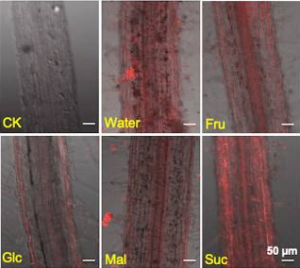A group from Institute of Plant Protection, Tianjin Academy of Agricultural Sciences, Tianjin, China, etc. has reported on a novel sucrose induced signaling cascade promoting Bacillus subtilis rhizosphere colonization.
https://www.ncbi.nlm.nih.gov/pmc/articles/PMC8397739/
It has been known that Bacillus subtilis is an excellent biological control agent, capable of suppressing a number of soil-borne phytopathogens. But, how do such beneficial bacteria recognize the signals from the plant host, colonize the roots, and ultimately establish an intimate relationship with the plant? One of the specific focuses is on plant root-released nutrients and their impact on the rhizobacteria. Among those root-released nutrients, sucrose is found most abundantly released into the rhizosphere. Sucrose is uniquely important to the plants since photosynthetic plants primarily use sucrose as a fixed carbon transport and storage mechanism among different tissues.
It is clearly shown in the figure below that sucrose induces more robust root colonization on tomato roots by Bacillus subtilis in the presence of sucrose than several other root-secreted sugars.
 A red fluorescence-labeled Batillus subtilis strain was used with different sugars (Fru: fructose, Glc: glucose, Mal: maltose, and Suc: sucrose)
A red fluorescence-labeled Batillus subtilis strain was used with different sugars (Fru: fructose, Glc: glucose, Mal: maltose, and Suc: sucrose)
Further, in the rhizosphere soil with sucrose addition, the relative abundance of Bacillus reached ~10.1%, while this ratio was only ~0.1% without sucrose addition, indicating a 100-fold increase in the abundance of the native Bacillus species in the rhizosphere stimulated by sucrose. In addition to the strong positive influence of sucrose on the prevalence of Bacillus, the relative low abundance of Pseudomonas (0.05%) was also elevated to 2.7% when inoculated with the wild type B. subtilis cells and further increased to 12.5% with simultaneous B. subtilis inoculation and sucrose supplementation. It was also shown that supplementation of sucrose formula improved the suppression efficiency against the soil-borne disease caused by Fusarium oxysporum sp. Lycopersici (Fusarium wilt) .
Big question is how B. subtilis manage to efficiently migrate in the semisolid or solid soil environment?
Regarding this question, authors has shown that sucrose activates a signaling cascade to trigger solid surface motility leading to effective root colonization by B. subtilis. That is, sucrose initiates biosynthesis of levan, and levan is further hydrolyzed into levanoligosaccharides, and finally induces strong production of surfactin from B. subtilis resulting in acceleration of solid surface motility.
